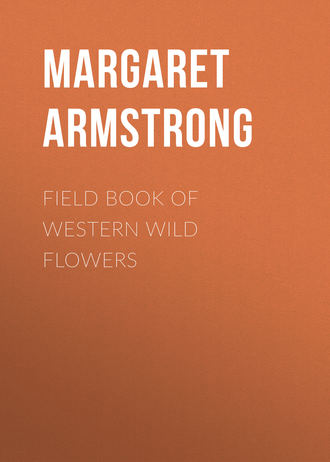 полная версия
полная версияField Book of Western Wild Flowers
California
This has small flowers, but it forms such large clumps that the effect of the golden-yellow clusters is handsome and very conspicuous, on dry hills and mountains and along roadsides in summer. It is woody below, from one to two feet high, and the leaves are more or less woolly. The variety discoídeum has no rays.
There are many kinds of Anthemis, natives of Europe, Asia, and Africa.
Mayweed, Chamomile, Dog Fennel
Ánthemis Cótula
White
Summer, autumn
U. S., etc.
This little weed is common in waste places and fields and along roadsides, almost all over the world. It is a branching annual, from one to two feet tall, with feathery light green foliage, cut into many long, narrow divisions, almost smooth, with a disagreeable smell and strong acrid taste. The many daisy-like flowers have heads about an inch across, with from ten to eighteen white rays and convex yellow centers. There is a picture of this plant in Mathews' Field Book.
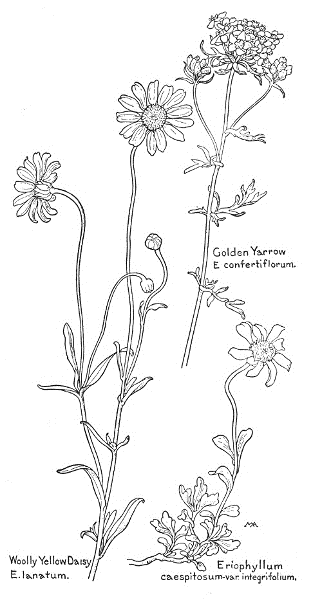
Golden Yarrow – E. confertiflorum.
Woolly Yellow Daisy – E. lanatum.
Eriophyllum caespitosum – var. integrifolium.
There are a good many kinds of Chaenactis, the flower-heads with tubular flowers only, but in some kinds the marginal flowers are larger and have a broad border resembling a kind of ray.
Chaenactis
Chaenáctis Douglásii
White
Spring, summer
Utah, Cal., New Mex.
A rather pretty plant, from eight inches to over a foot tall and more or less downy, with stiffish, gray-green, leaves, cut into many short, blunt lobes and teeth. The flower-heads are about an inch long, and contain numerous small, pearly-white or pinkish, tube-shaped flowers, with long, purplish pistils. This grows in dry open places, the flowers turn pink in fading and are sweet-smelling and quite pretty, though not striking. C. macrántha, which grows in the Grand Canyon, has similar flowers, rather prettier, with a somewhat sickly scent, but it is a lower plant.
Golden Girls
Chaenáctis lanòsa
Yellow
Spring
California
A charming desert plant, with several downy stems, over a foot tall, springing from a feathery cluster of pretty, bright green, thickish leaves, cut into narrow divisions, rather downy and often tinged with red. The flower-head is nearly an inch and a half across, without rays, but the marginal flowers in the head are larger and have broad borders that look like rays. They are a beautiful shade of clear bright yellow.
Morning Bride
Chaenáctis Fremóntii
White
Spring
Southwest
This is very much like the last in size, form, and foliage and is equally charming, but the flowers are all pure white, or pinkish, instead of yellow. It is one of the most attractive of the white desert flowers.
Desert Star
Erimiástrum bellidoìdes
Lilac
Spring
Arizona
A charming little desert plant, with spreading stems and small, narrow, toothless, gray bluish-green leaves, which are soft, but sprinkled with small, stiff, white bristles, the whole forming a rosette, five or six inches across, growing flat on the sand and ornamented with many pretty little flowers. They are each set off by a little rosette of leaves and are over half an inch across, with pinkish-lilac rays, shading to white towards the yellow center and tinted with bright purple on the back.
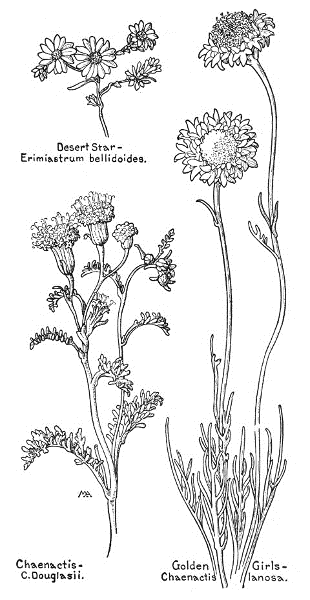
Desert Star – Erimiastrum bellidoides.
Chaenactis – C. Douglasii.
Golden Girls – Chaenactis lanosa.
Venegasia
Venegàsia carpesioìdes
Yellow
Summer
California
These big, leafy plants, with their bright flowers, are a splendid feature of the California woods and canyons in June, especially on the slopes of the Santa Inez mountains, where they often cover large areas with green and gold; unfortunately the smell is rather disagreeable. The leafy stems are four or five feet high, nearly smooth, with alternate, bright green leaves, almost smooth and thin in texture, and the flowers, resembling Sun-flowers, are over two inches across, with clear yellow rays, an orange center, and an involucre of many green scales, overlapping and wrapped around each other, so that the bud looks much like a tiny head of lettuce. This was named for Venegas, a Jesuit missionary, and is the only kind, growing near the coast in the South.
Lessingia
Lessíngia leptóclada
Lilac
Summer
California
This is a slender plant, from six inches to two feet tall, with pale gray green, woolly leaves, the lower ones somewhat toothed, and pale pinkish-lilac flowers, not very conspicuous in themselves, but sometimes growing in such quantities that they form pretty patches of soft pinkish color in sandy places. The flower-head is about half an inch long, with no rays, but the outer flowers in the head are larger and have long lobes resembling rays. This is very variable, especially in size, and is common along dry roadsides and quite abundant in Yosemite. The picture is of a small plant. L. Germanòrum, which is common on sandy hills along the coast from San Francisco to San Diego, has yellow flowers and blooms in autumn.
There are many kinds of Baeria, not easily distinguished.
Sunshine, Gold Fields
Baéria grácilis
Yellow
Southwest
This is a dear little plant, often covering the fields with a carpet of gold. The slender stems are about six inches tall, with soft, downy, light green leaves, usually opposite, and pretty fragrant flowers, about three-quarters of an inch across, with bright yellow rays and darker yellow centers. This is sometimes called Fly Flower, because in some places it is frequented by a small fly, which is annoying to horses. B. macrántha is a much larger plant, a biennial, with a tuberous root, from seven inches to a foot and a half tall, with long, narrow, toothless leaves, with hairy margins, and flower-heads from an inch to an inch and a half across, with yellow rays and hairy involucres. This grows along the coast in California, blooming in May and June.
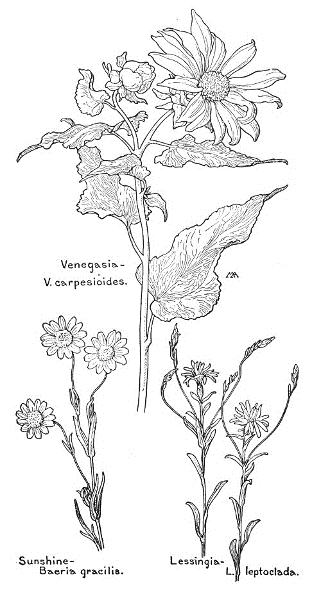
Venegasia – V. carpesioides.
Sunshine – Baeria gracilis.
Lessingia – L. leptoclada.
There are several kinds of Bahia, natives of western North America, Mexico, and Chile, herbs or shrubs, more or less woolly.
Bahia
Bàhia absinthifòlia
Yellow
Spring
Arizona
This is from eight to fifteen inches tall, with pretty flowers, an inch and a half across, with bright yellow rays and deep yellow centers, contrasting well with the pale gray-green foliage, which is covered with close white down. This grows in arid situations on the mesas and often forms clumps.
There are several kinds of Crassina, natives of the United States and Mexico.
Desert Zinnia
Crassìna pùmila (Zinnia)
White
Spring
Arizona
Nothing could look much less like a garden Zinnia than this dry, prickly-looking dwarf shrub. It is from three inches to a foot high, the branches crowded with very small, stiff, dull green leaves, and the flowers are about an inch across, rather pretty but not conspicuous, with a yellow center and four or five, broad, cream-white rays, often tinged with dull pink. This plant grows on the plains and is a "soil-indicator," as it flourishes on the poorest, stoniest, and most arid land.
Wild Marigold
Bàileya multiradiàta
Yellow
Spring, summer, etc.
Southwest, Tex.
Charming flowers, with a thrifty, cultivated appearance like that of a garden flower. The plant is a foot tall, with grayish-green, woolly stems and foliage, and the handsome flower is an inch and a half across, with a fine ruffle of many bright yellow rays, prettily scalloped, and a yellow center, rather deeper in color. In Arizona bouquets of these flowers may be gathered during every month in the year.
Bàileya pauciradiàta
Yellow
Spring
Southwest
An odd little desert plant, about six inches tall, with a thickish stem and soft, thickish leaves, covered all over with silky, white wool, giving a pale, silky effect to the whole plant, which is quite pretty, though the pale yellow flowers, each about half an inch across, are not striking.
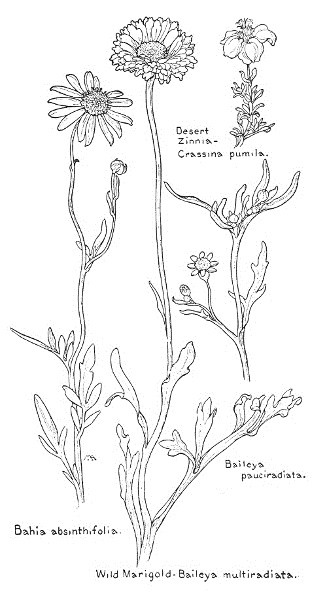
Desert Zinnia – Crassina pumila.
Baileya pauciradiata.
Bahia absinthifolia.
Wild Marigold – Baileya multiradiata.
Pentachaeta
Pentachaèta àurea
Yellow
Spring
California
Gay, yet delicate little flowers, with slender branching stems, about eight inches tall, and light green, very narrow leaves. The flowers are an inch across, with a feathery ruffle of very numerous narrow rays, light yellow at the tips, growing deeper towards the orange-colored center, and the pretty buds are often tinged with pink or purple. This often grows in patches and is common in southern California.
Daisy Dwarf
Actinolèpis lanòsa
White
Spring
Arizona
A quaint little desert plant, only two or three inches tall, with thickish, pale gray-green leaves, covered with close white down, and pretty little flowers, growing singly at the ends of tiny branches, each half an inch across, with a yellow center and pure white rays, which fold back at night. These little flowers are too small to be very conspicuous, but are charming in effect, sprinkled over the bare sand, and when growing in quantities on nearly bare mesas give a whitish appearance to the ground.
There are a good many kinds of Blepharipappus.
Yellow Tidy-tips
Blepharipáppus élegans (Layia)
Yellow
Spring
California
Very pretty flowers, with slender, branching, hairy stems, about a foot tall, and light green, hairy leaves. The flowers are about two inches across, with yellow rays, tipped with white or very pale yellow, neatly arranged around the deep yellow centers, which are specked with black. The rays twist up in fading and turn to a pretty shade of dull pink. This is common and a very handsome kind.
White Tidy-tips
Blepharipáppus glandulòsus (Layia)
White
Spring
Southwest, Oreg., Wash.
A beautiful kind, eight or nine inches tall, with pale green, hairy leaves, the lower ones toothed, and a slender stem, bearing a charming flower, nearly an inch and a half across, with neat pure white rays and a bright yellow center. This grows in mountain canyons and is widely distributed as far north as British Columbia.
There are several kinds of Gaillardia, all American. They are much cultivated in gardens, were named in honor of Gaillard de Merentonneau, a French botanist.
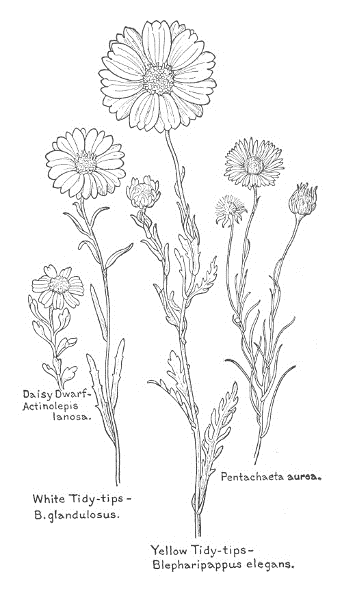
Daisy Dwarf – Actinolepis lanosa.
Pentachaeta aurea.
White Tidy-tips – B. glandulosus.
Yellow Tidy-tips – Blepharipappus elegans.
Blanket-flower, Gaillardia
Gaillàrdia pinnatífida
Yellow
SummerAriz., Col., Tex.
This is handsome and conspicuous, with a slender, rough stalk, about a foot tall, dull green, stiff, rather hairy leaves, mostly from the root, and beautiful flowers, an inch and a half across, with golden-yellow rays, with three teeth, and a center of shaded maroon and yellow, which is very velvety and pretty and becomes an attractive, purplish, fuzzy, round head when the rays drop off. This grows on the plains. G. aristàta, found throughout the West and as far east as Colorado, is an exceedingly handsome kind, sometimes over two feet tall, with beautiful yellow flowers, sometimes measuring four inches across.
Arizona Gaillardia
Gaillàrdia Arizònica
Yellow
Spring
Arizona
A pretty little desert plant, from four to eight inches tall, with a slender, downy flower-stalk, springing from a cluster of roughish, light dull green leaves, more or less hairy and bearing a single handsome flower, nearly two inches across, with a downy involucre and three-toothed rays of an unusual and pretty shade of dull light yellow, finely veined with brown on the back, surrounding a darker yellow, fuzzy center.
Tiny Tim
Hymenathèrum Hartwégi
Yellow
Spring
Arizona
A neat little evergreen, shrubby plant, only about three inches high, with branching stems, clothed with small, narrow, dull green leaves, which look prickly but are actually not very stiff, though tipped with tiny bristles. The flowers are three-eighths of an inch across, very perfect in outline, with bright yellow rays and deeper yellow centers, and the whole effect, of a tiny shrub sprinkled with flowers, is quite attractive, growing on very dry ground along the roadside. The plant has a pronounced smell, which is not unpleasant.
Tall Purple Aster
Machaeranthèra incàna (Aster)
Purple
Spring
Southwest, Utah, New Mex.
This looks a good deal like an Aster, a branching plant, from two to nearly three feet high, with grayish-green, slightly downy leaves, with very sharp teeth. The flowers are an inch and a half across, with narrow, bright violet rays and bright yellow centers. This grows abundantly in valleys.
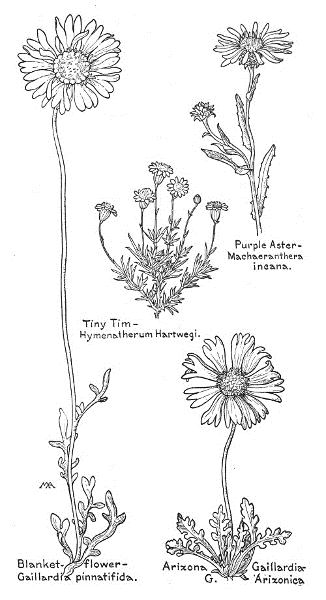
Purple Aster – Machaeranthera incana.
Tiny Tim – Hymenatherum Hartwegi.
Blanket-flower – Gaillardia pinnatifida.
Arizona Gaillardia – G. Arizonica.
Laphàmia bisetòsa
Yellow
Summer
Ariz., New Mex., Tex.
An insignificant plant, except that it grows on the sides of bare, red rocks or head-downward on the under side of overhanging ledges, apparently needing little or no soil, and is therefore noticeable. It forms round clumps, one or two feet across, with many slender stems, about six inches high, small, pale yellowish-green, roughish leaves, and small yellow flower-heads, without rays. This is rare and grows in the Grand Canyon.
There are several kinds of Grindelia, common in the West, recommended as a remedy for Poison Oak.
Gum Plant
Grindèlia latifòlia
Yellow
Spring
California
Coarse but rather effective flowers, with smooth, stiff, branching stems, about three feet high, and dark dull green leaves. The flower-heads are over an inch and a half across, with bright yellow rays and centers and very resinous, shiny buds.
There are several kinds of Balsamorrhiza. Both the Latin and common names allude to the aromatic roots.
Arrow-leaf Balsam-root, Big Root
Balsamorrhìza sagittàta
Yellow
Spring
Utah, Ida., Cal., Nev., Col.
A very handsome plant, the contrast between the gray-velvet leaves and the great yellow flowers being very striking. It forms large clumps, about a foot and a half high, with slightly downy flower-stalks and heart-shaped or arrow-shaped, toothless leaves, pale gray-green and velvety, covered with silvery down, whiter on the under side. The flowers are over three inches across, with clear bright yellow rays, and a deeper yellow center, fuzzy and greenish-yellow in the middle. The involucre is almost white, thickly covered with silvery, silky wool, and the flowers are pleasantly sweet-smelling. This grows on dry hillsides.
Cut-leaved Balsam-root
Balsamorrhìza macrophýlla
Yellow
Spring, summer
Utah, Wyo.
A strikingly handsome plant, forming clumps even larger than the last, with similar flowers, but with quite different foliage. The leaves are rich-green, and decorative in form, more or less slashed into lobes and very sticky, with hairy margins and leaf-stalks, and are nearly as tall as the hairy, sticky flower-stems, from one to two feet high. This grows in rich soil in mountain valleys.

Cut-leaved Balsam Root – Balsamorrhiza macrophylla.
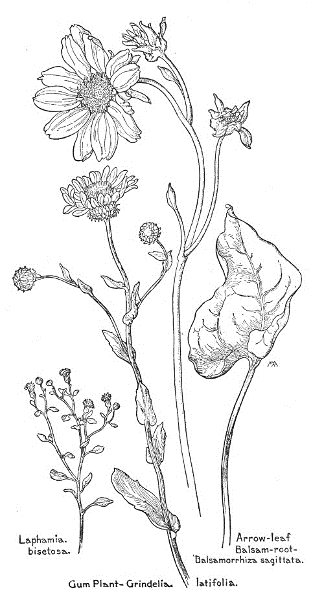
Laphamia bisetosa.
Gum Plant – Grindelia latifolia.
Arrow-leaf Balsam-root – Balsamorrhiza sagittata.
Balsam-root
Balsamorrhìza Hóokeri
Yellow
Spring
West, except Ariz.
Rather handsome, though a coarse plant, over a foot tall, with hairy, dull green or grayish leaves, crisp and harsh to the touch, variously lobed and cut, chiefly in a clump at the root. The flowers are numerous, from an inch and a half to over two inches across, with deep orange-yellow rays, and grow singly on long flower-stalks. This flourishes on dry plains and mesas.
There are several kinds of Wyethia, resembling Balsam-roots, but their thick roots not resinous.
Yellows, Mule-ears
Wyéthia amplexicàulis
Yellow
Spring, summer
Utah, Nev., etc.
A robust and exceedingly handsome plant, one or two feet tall, with rich foliage and gorgeous flowers. The leaves are stiffish, dark rich green, smooth but somewhat sticky, often toothed; the stem-leaves alternate, their bases partly clasping, and the root-leaves a foot or two long and two or three inches broad, with leaf-stalks. The flower-heads are about four inches across, with bright yellow rays, almost orange color, and the center with three rows of yellow disk-flowers, surrounding a clump of pointed, overlapping, stiff, greenish scales in the middle. This sometimes forms immense patches on dry hills at rather high altitudes, as far east as Colorado. It is sometimes called Compass Plant, because its leaves are thought to point North and South, and the Indian name is "Pe-ik."
Woolly Wyethia
Wyéthia móllis
Yellow
Summer
California
Not so handsome as the last, but a striking plant, from one to four feet high, with gray-green, velvety foliage, all covered with soft wool, forming large clumps of leaves, from six to fifteen inches long. The flowers are two or three inches across, with orange rays and very woolly involucres. This is common in dry places in Yosemite.
There are several kinds of Rudbeckia, all North American.
Black Eyed Susan
Rudbéckia hírta
Yellow
Summer
California, etc.
From one to four feet high, with rough leaves and one or a few handsome flowers, from one to four inches across, with deep yellow rays and a purplish-brown conical center. This comes from the Mississippi Valley, is very common in the East, and becoming common in Yosemite meadows.
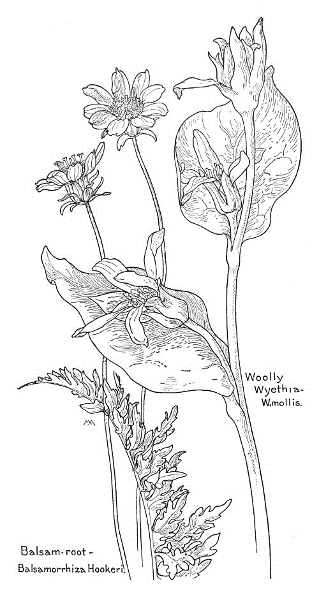
Woolly Wyethia – W. mollis.
Balsam-root – Balsamorrhiza Hookeri.
Brass Buttons, Butter-heads
Cótula coronopifòlia
Yellow
Spring, summer, autumn
Cal., Oreg.
This little weed comes from South Africa, but is now common in wet places, especially in the salt marshes around San Francisco Bay, often carpeting the sand and mud with its succulent, trailing stems. The bright green leaves are alternate and smooth, clasping the stem at base, some with toothless edges, others variously cut and lobed, and the flower-heads are about half an inch or less across, like the bright yellow center of a Daisy, without rays. Matricària matricarioìdes is another little weed, common along roadsides, with conical, greenish-yellow flower-heads, without rays, and feathery foliage, which has a strong pleasant fruity smell when crushed, giving it the name of Pineapple-weed and Manzanilla.
Tetradymia
Tetradýmia spinòsa
Yellow
Spring
West, etc.
An odd desert shrub, about three feet high, with gray bark and crooked, gnarly, tangled branches, armed with long spines and clothed with small, downy, pale green leaves. The flower-heads are three-quarters of an inch long, without rays, with pale yellow tube-shaped flowers and downy, white involucres, and are so crowded on the twigs that they appear to be loaded with them, but the coloring is too pale to be effective. This is common in the Mohave Desert and elsewhere on dry hills and plains, as far east as Colorado.
There are a great many kinds of Solidago, most of them natives of North America. On the whole, the western Golden-rods are not so fine as the eastern ones, nor are there so many kinds, though there are quite enough to puzzle the amateur, as they are difficult to distinguish.
Arizona Golden-rod
Solidàgo trinervàta
Yellow
Summer
Arizona
A handsome kind, from one to two feet high, with flower-heads nearly three-eighths of an inch across, with bright yellow rays and centers, forming a large, handsome, plume-like cluster. The stem and leaves are dull bluish-green, rather stiff and rough, the lower leaves with a few obscure teeth. This grows at the Grand Canyon. S. occidentàlis, Western Golden-rod, is smooth all over, with leafy stems, from three to five feet tall, toothless leaves, and flat-topped clusters of small, yellow, sweet-scented flowers. This grows in marshes and along the banks of streams, in California, Oregon, and Washington, blooming in summer and autumn. S. Califórnica, California Golden-rod, is from two to four feet high, with grayish-green, roughish leaves, the lower ones toothed, and small yellow flowers, forming dense pyramidal clusters, from four to thirteen inches long. This grows on dry plains and hillsides and in the mountains, throughout California and in Oregon, blooming in the autumn. It is called Orojo de Leabre by the Spanish-Californians.
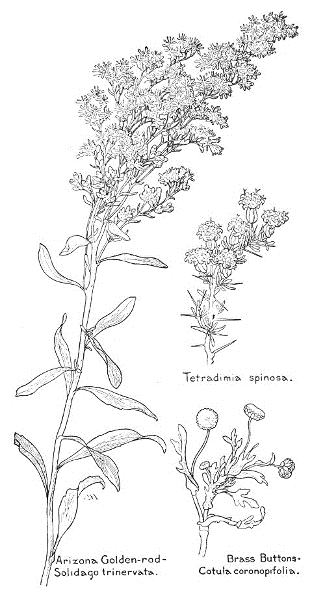
Tetradymia spinosa.
Arizona Golden-rod – Solidago trinervata.
Brass Buttons – Cotula coronopifolia.
There are probably over a thousand different kinds of Senecio, very widely distributed. The name is from the Latin for "old man," in allusion to the long white hairs of the pappus, when "gone to seed." Our kinds have many common names, such as Groundsel, Ragwort, and Squaw-weed.

